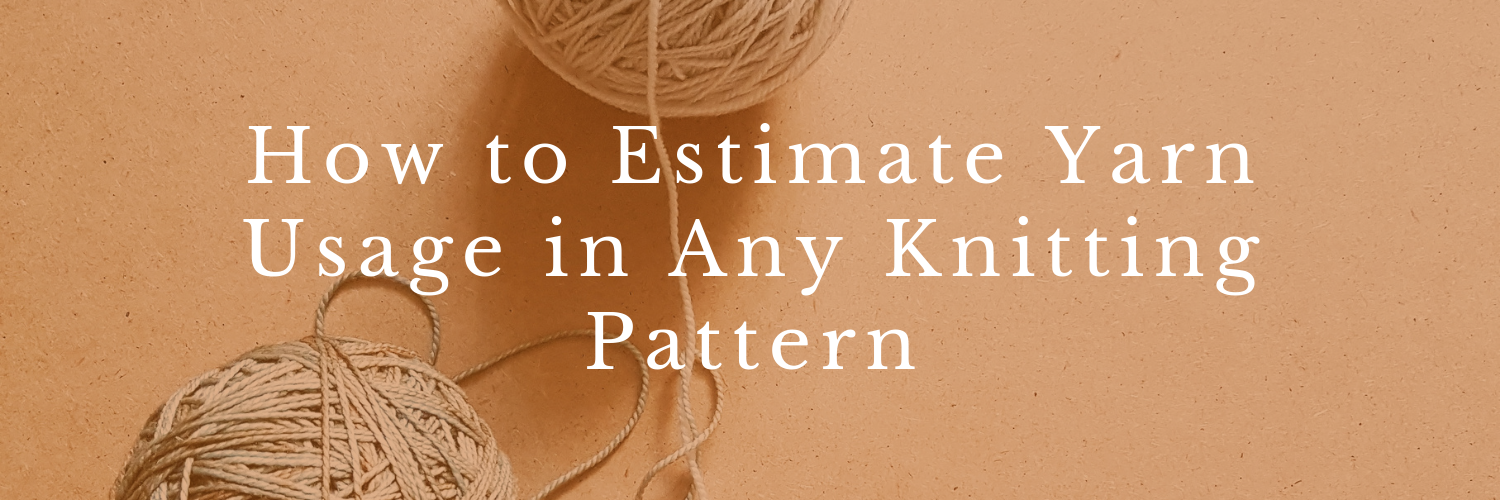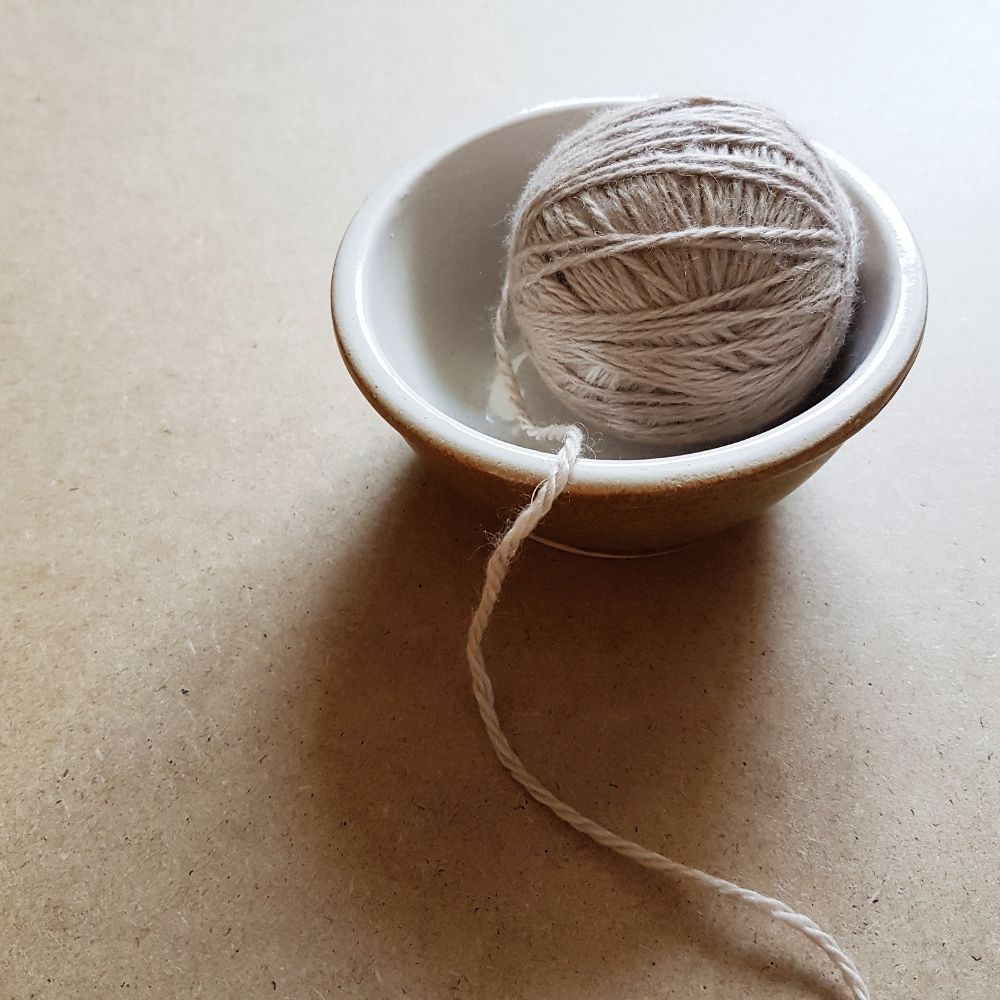How to Estimate Yardage in Knitting Patterns
Estimating yardage for the size you knitted the sample in is pretty straight-forward, but how do you work out the yarn usage for the remaining sizes without having to knit them first? This is a question that many knitting pattern designers ask when they’re just starting out.
I used to dread this part of the process too because I was afraid of getting my calculations wrong and letting down the people who were knitting my patterns. I was using a method that involved measuring how much yarn was used per stitch, but I didn’t feel sure that it was accurate.
Later, I discovered a method that I feel a lot more confident in - and that is the one I’m going to show you today. Using your knitted sample, some simple equations and my favourite tool, the spreadsheet, I am going to show you how to work out your yarn requirements for all the sizes in any pattern.
Spreadsheet Setup
Start by putting the following finished garment measurements for all sizes into your spreadsheet:
Bust width (unless there is another part of the body that is wider)
Garment length
Upper arm width (unless there is another part of the sleeve that is wider)
Sleeve length
If your garment has a very large shawl collar or something else that will require a lot of yarn, take note of the width and length of that piece/section too.
If you are making an accessory rather than a garment, you just need the width of the widest point and the length of the longest point.
Even though I prefer to reference both cm and inches in my patterns, I use only cm for these measurements since they are just for my own reference and will not be included in the pattern.
Calculate the Total Garment Area
Using the finished garment measurements from our spreadsheet, we are now going to work out the total area of the garment in cm².
Total Area of the Body
We will start by working out the approximate area of the body (both back and front) by using the following calculation.
(Bust width * Garment length) * 2 = Body area
Spreadsheet Formula: =(Bust width*Garment length)*2
You can calculate this in your spreadsheet by using the formula above, replacing Bust width and Garment length with the appropriate cell reference. Use it in the first size’s cell and then drag it across the cells for the remaining sizes. If you don’t know how to drag formulas, I show you how in my blog post on How to Grade Knitting Patterns Using a Spreadsheet.
For example, in my cell for the size 5 (XL), it says =(J3*J4)*2 which essentially means =(59.5*62)*2. The result is 7378, which means that the area of the body measures 7378 cm².
Total Area of the Sleeves
Work out the approximate area of both sleeves by using this calculation
(Upper arm width * Sleeve length) * 2 = Sleeve area
Spreadsheet Formula: =(Upper sleeve width*Sleeve length)*2
Use your spreadsheet to calculate this by replacing Upper sleeve width and Sleeve length with the appropriate cell references. Remember to drag the formula across all sizes.
Total Area of the Garment
Now that we know the approximate total area of the body and sleeves, we can calculate the total area of the garment.
Body area + Sleeves area = Total area
For my size 5 (XL), the cell says =J10+J11. The result tells me that the total area of my size 5 (XL) garment is 11567 cm². This total area calculation isn’t exact (it bases the estimation on the widest and longest measurements in each piece of your garment) but the extra yarn that comes from this overestimation will likely be used up in neckbands, front bands and in subtle gauge differences.
FREE, ON-DEMAND VIDEO WORKSHOP
How to Confidently Design Multi-Size Sweater Patterns
Calculate Swatch Area
I always expect knitters to swatch so I have decided that, going forward, I will include extra yarn for a 20 x 20cm swatch to ensure that they don’t end up playing yarn chicken. Side note: I will mention this in the yardage section so that makers know I have already allocated yarn for this purpose!
This one is even easier to calculate. You just use the following spreadsheet formula: =swatch length*swatch width
For a 20x20cm swatch, my cell will say =20*20 giving me a result of 400, i.e. 400 cm².
Weigh your sample garment
Before you make your final yarn estimations, you will need a finished sample. It doesn’t matter which size - it just needs to be finished.
Weigh the sample in grams and put the figure in the correct column according to the size of the sample. Do not fill out the other size columns - I just put a dash in those columns to help me remember that I intentionally left them blank.
Grams per cm² in Your Sample
This is one of the most crucial calculations you will make, since it will influence your yarn estimations for the remaining sizes. Figure out how many grams of yarn is used per cm² with the following calculation:
Weight of sample in grams / total sample area in cm² = grams per cm²
Spreadsheet Formula: =Weight of sample in grams/Total sample area in cm²
In your spreadsheet, replace Weight of sample in grams and Total sample area in cm² with the appropriate cell references for that size. For my size 5 (XL) sample, I wrote =J19/J12 in the cell, which is essentially saying =530/11567. From this calculation, I know know that my pattern uses 0.045820005 grams of yarn per cm².
Yarn Estimation for All Knitting Pattern Sizes
Now, we are getting to the knitty gritty (…sorry!) of yarn estimation. First, we first need to fill out the yarn details, both weight and the meterage, under each size. My yarn example weighs 50g and measures 183m per skein.
Estimate the Garment Weight for All Sizes
In order to estimate the garment weight for sizes that we haven’t knitted a sample, you take the total area that we calculated earlier on and multiply it by the grams per cm² we just worked out.
Total area in cm² * Grams per cm² in sample = Estimated garment weight in grams
Spreadsheet Formula: =Total area in cm²*Grams per cm² in sample
For size 6 (2XL), my cells says =L13*J18 which essentially means =13225.5*0.04428846, giving me an estimated garment weight of 585.7370268 grams. The same formula can be used on all sizes.
Estimate the Swatch Weight
The same formula can be used to estimate the weight of the swatch.
Estimate the number of skeins needed
Calculating the number of skeins of yarn needed is easy, now that we know approximately how much a garment in each size would weigh.
(Estimated garment weight + Swatch Weight) / Skein weight = Approx number of skeins needed
Spreadsheet Formula: =(Estimated garment weight+Swatch weight)/Skein weight
Replace Estimated garment weight, Swatch weight and Skein weight with the appropriate cell references and drag the formula across all sizes. For size 5 (XL), my cells says =(J28+J29)/J23, which means =(530+18.32800207)/50. From this calculation, I know that I will need 10.96656004 skeins of my recommended yarn for this size.
Work out the estimated meterage
Once you know how many skeins of yarn are needed to knit each size, you can work out the estimated meterage per size. It’s important that we work this out so that makers can easily make yarn substitutions using the yarn usage recommendations.
Estimated skeins needed * Yarn meterage = Estimated Meterage
Spreadsheet Formula: =Estimated skeins needed*Yarn Meterage
Going back to my size 5 (XL) example, I wrote =J30*J24 in the cell, which means =10.96656004*183. My calculation tells me that this sizes uses approximately 2006.88 metres of yarn.
Finalise the Number of Skeins Needed
We are at the finish line! Finalise the number of skeins needed per size by rounding up your skein estimation to the nearest full skein i.e. 0 decimal places. This is the spreadsheet formula I use to do this:
Spreadsheet Formula: =ROUNDUP(Approx number of skeins needed,0)
For my size 5 (XL) garment, I wrote =ROUNDUP(J30,0) which means =ROUNDUP(10.96656004,0). Based on this calculation, I now know I need to recommend purchasing 11 skeins of my recommended yarn.
Yarn Estimation Isn’t So Scary
I know that probably looked like a lot of information, but if you take it step by step, it really isn’t so bad. Follow these instructions and you will end up with yarn usage estimations that you can be confident in.
Now, what part of estimating yardage do you find most difficult? Share with our community in the comments section and I will do my best to help you.













